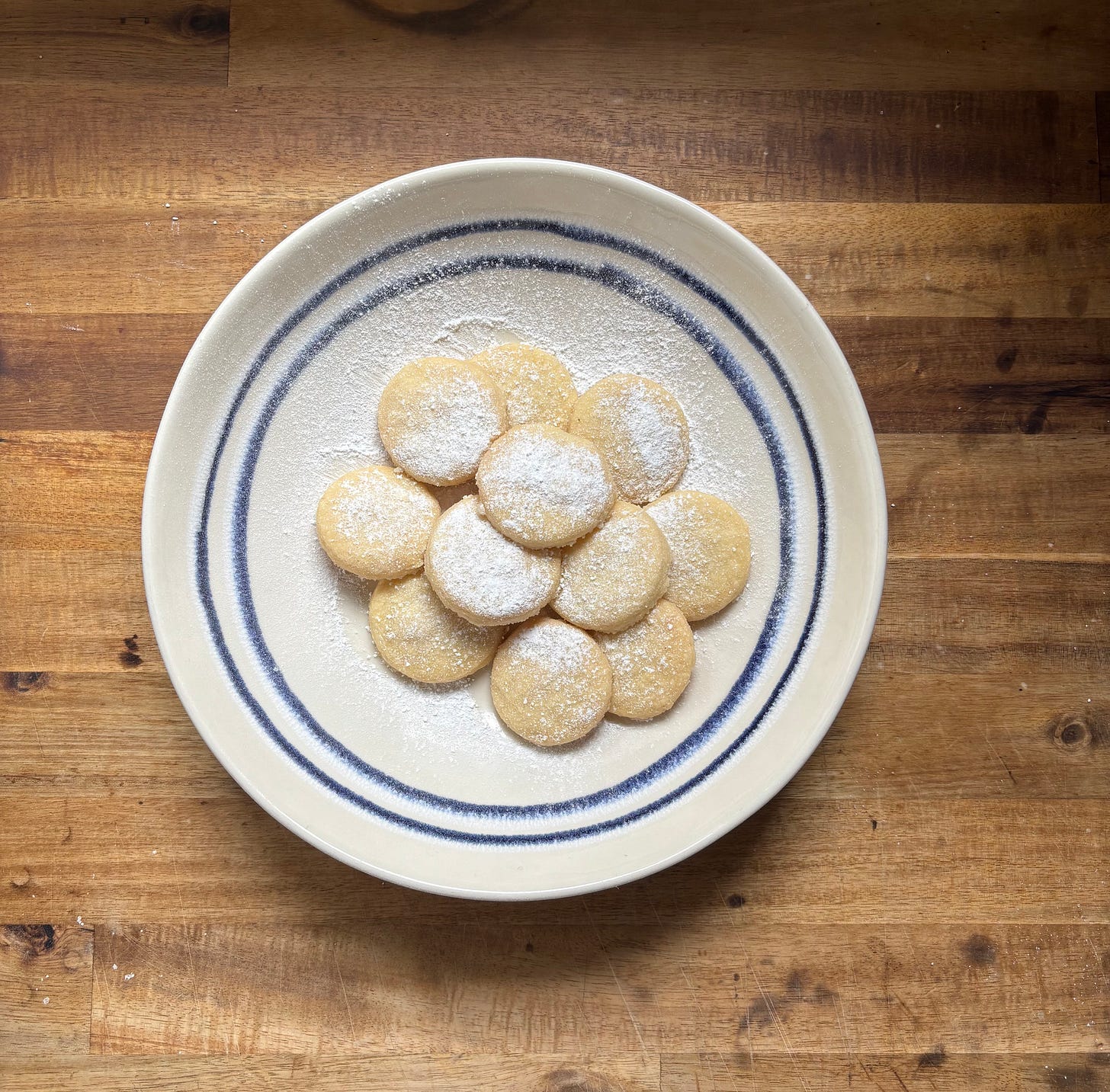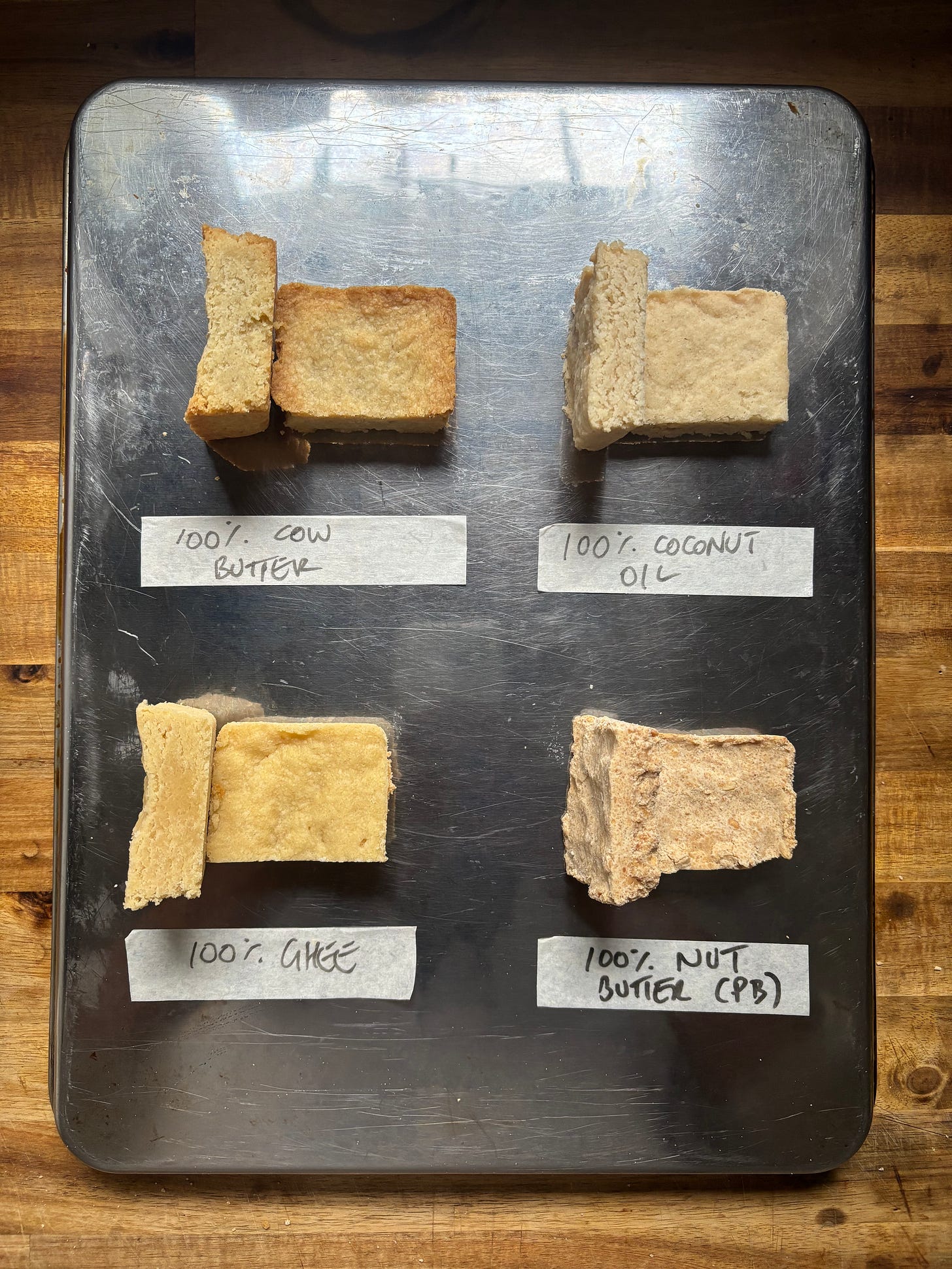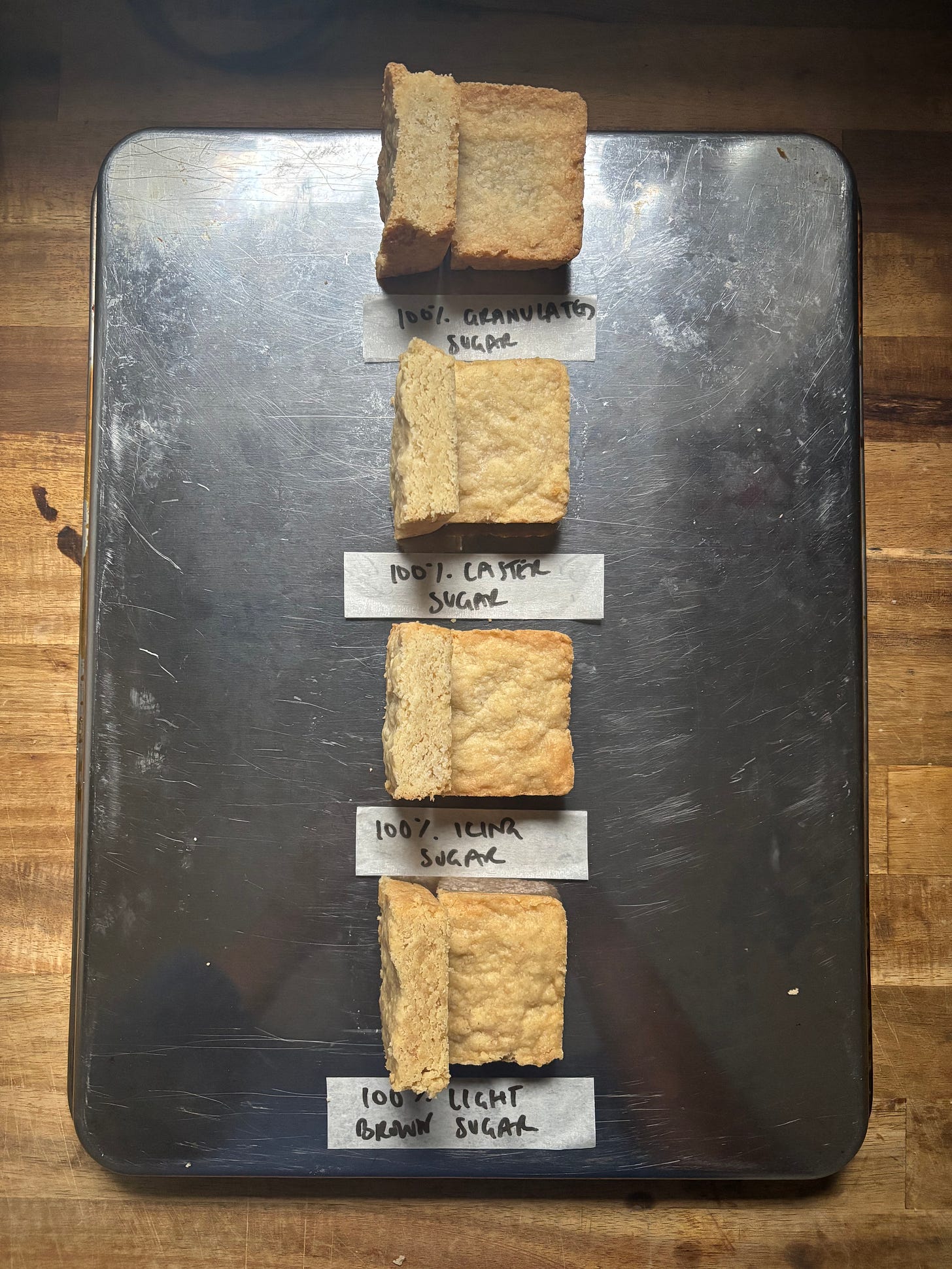HOW FOOD WORKS: Perfecting Shortbread
On the role of starch, fat and water contents, need-to-know techniques and of course, the shortbread recipe secret.
Everybody has a granny that makes the best shortbread. Mathematically that’s impossible, but somehow in a freakish stroke of sheer luck, I have found the winning granny. This granny is sadly not mine, I don’t think my gran even knows what shortbread is, but, I am close enough to their inner circle that I’ve been trusted with the secret. Terrible idea really, because now I'm blabbing about it to all of you.
I joke, Fionn’s granny has consented to this in the name of science - a true heroine! And in order to verify her prestigious shortbread-master status, I spent the bank holiday weekend caring out some very serious experiments.
Not only did they prove her baking prowess, they also uncovered some very interesting discoveries and inspired a bake I am truly, truly proud of in this week’s TK. Today, we dive into all things shortbread.
The Breakdown:
The rule of shortbread is deceptively simple: 1:2:3; 1 part sugar, 2 parts butter and 3 parts flour.
It’s a very simple formula, so we know what that means - there are many hidden pitfalls.
Shortbread is known for its ‘short’ nature, i.e. melt-in-the-mouth, tender and crumbly. It’s a biscuit that feels so surprisingly decadent for its very humble ingredients, but owes its character to its high fat to flour ratio.
This week we discuss what makes shortbread shortbread, how we can play with the basics, experiments to elevate and the discoveries of our labour.
We want to strike the perfect balance between luscious and structural.
- The Starch
Why zero in on starch and not flour?
Flour is one of those misleading ingredients. Like many, it’s an ingredient made up of other ingredients. Starch is one of them (70-75% in typical plain flour), and protein, fibre and minerals make up the rest.
Starch is the backbone of shortbread - it shapes its structure, texture and crumb. It absorbs moisture, which in turn forms structure. The moisture causes it to gelatinise during baking, creating the beautiful melt-in-the-mouth shortbread texture we all know and love. Starch actually accentuates the ‘short’ texture in shortbread, by soaking up any available moisture, limiting gluten development.
Actually, where does gluten come into this?
All gluten is protein, but not all protein is gluten. Gluten is a combination of the wheat proteins gliadin and glutenin, which when introduced to water, combine to form a stretchy, elastic gluten network. Gluten is responsible for chew, think pizza and bread loaves - not the desired texture of shortbread.
But, we do still need this network, just very little of it. It helps bind our dough together and give it some structural integrity. Without it, we’re left with a crumbly, unshape-able mess. We want a balance of tenderness (from the starch), and structure (from the gluten) to achieve the perfect shortbread.
Flours contain starch and sometimes gluten, but in different ratios, hence why they can’t be used so interchangeably. You need that gluten-starch balance.
I did some experiments to test out different combinations, with my control as the bakers ratio with plain flour, dairy butter and granulated sugar.

Let’s start with cornflour, which improved the texture of the final result so drastically - incredible considering how good the control was. And guess who had this figured out already? That’s right - Fionn’s granny. Her secret weapon is cornflour, along with many other technical tips that I am sadly not inner-circle enough to learn (nor is Fionn apparently, a much harder pill to swallow…).
Almond flour brought such a wonderful flavour and texture to the mix, creating a really ‘adult’ biscuit. I loved it so much that it inspired the creation of this week’s TK recipe (more details on final ratios, and experiment findings can be found in TK)!
- The Fat
The next important ingredient is the fat source, and boy does it shape the end result.
First of all, what do we want from our fat?
Fat needs to coat the particles of our flour choice to form a barrier that blocks any water from hydrating our gluten proteins. Remember, less gluten hydration = less gluten formation = keeping that shortbread texture short! To do this, we need to a) think about the fat content of our fat source and b) make sure the fat is softened enough that it can easily coat the flour particles without immediately hydrating the gluten, or, require a lot of mixing (agitation also helps gluten networks form).
If your fat source contains water (e.g. butter is ~18% water), you want it softened enough to easily coat your flour but not so softened that it splits. The split breaks the emulsion (for example, fully melted better), which releases all the water. Once you mix this with the flour, the gluten proteins will immediately hydrate as there is no time for the fat to coat the flour particles before the water finds them. If your fat source is 100% fat, you don’t have the worry of water, but fully liquid fats are actually less effective at coating flour particles. The rule of thumb is: always softened, never melted.
I conducted some experiments to see just how much the use of different fat sources affected the final bake. What I discovered? A lot.
I think the main highlight of these experiments was how much water (or lack thereof) affects the shortbread dough, as well as fat. The biggest takeaway was: low fat is a no-go. Peanut butter produced a biscuit so dry and sandy, I don’t think we can, in good conscience, still call it a biscuit. Ghee and coconut oil on the other hand, although producing pretty different bakes texturally, resembled a much closer structure to the dairy butter control, and we can put this down to the high fat contents.
I’ll be going into more detail on ratios and light-bulb discoveries in TK.
- The Sugar
Sugar makes up the smallest ratio of our ingredients, but that doesn’t mean it’s not important. It isn’t just responsible for sweetness, but for structure and texture too.
Caster sugar is the OG in the shortbread game. It’s fine textured enough that it can easily dissolve into the dough, blend smoothly with the fat and evenly disperse, but not too fine that it overdoes it, resulting in a final bake almost too soft and delicate, it instantly turns to mush in the mouth.
The darker the sugar, the higher the water content, increasing dough hydration and thus shortbread softness. Softness isn’t the same as tenderness, it’s more cake-y than smooth and luscious. There are benefits though - the molasses flavour brings with it caramel notes and complexity, taking the shortbread flavour somewhere different, and, dare I say it, more interesting.
Then, we come to liquid sugars: honey, maple syrup and golden syrup. The liquid content takes a massive leap upwards, which will most certainly drastically effect things. For starters, gluten will be having a field day. Keeping the water away will be an impossible task, it’s best to accept you will be dining on cake instead of biscuits. Second, your dough will be so soft it will spread significantly whilst baking, changing not only the texture of your ‘shortbread’, but the technique of making it.
I carried out some sugar experiments as well (it was a real shortbread-heavy easter in my house).
Caster was the clear winner. Granulated was also lovely, but it was of those experiences where you bite into one and think ‘ooooh niiiice’, and then you bite into the other and think ‘I didn’t realise this could get better’. Icing sugar was lacklustre, and felt like sugar had barely been added at all, whilst light brown sugar produced a grainy texture with a too-subtle sweetness. More in-depth findings are over in TK.
- The Technique
Remember those pitfalls we were talking about? They’re all in the technique.
Repeat it with me: we don’t want gluten networks forming.
So, how do we stop them?
Do not over-mix your dough! Agitation = gluten formation!
Keep your fat source super soft.
We also have nowhere to hide with this, so please, buy the good butter!
To read the recipe with step by step explanations, subscribe to receive ‘TEST KITCHEN’ where we will also go over the comprehensive cheat sheet for this technique, troubleshooting, key details, graphics and science backed flavour pairings.
Happy eating and thanks for reading!
Fiona :)
Any questions, let me know below!










Love all of your test kitchen themes and breaking this out into each one of the components!
For the sugar and fat ones, did you use straight AP flour still, or did you use the corn flour one? Same for the sugar one - did you just use butter and AP flour? Just trying to hone in the best recipe here and wasn’t sure if you crossed some of the variables 🕵️♂️
This was such an interesting read! I love the way you break everything down, I felt like I was in a fun chemistry class. Please don’t ever stop experimenting, it’s so helpful for us who cook and bake.